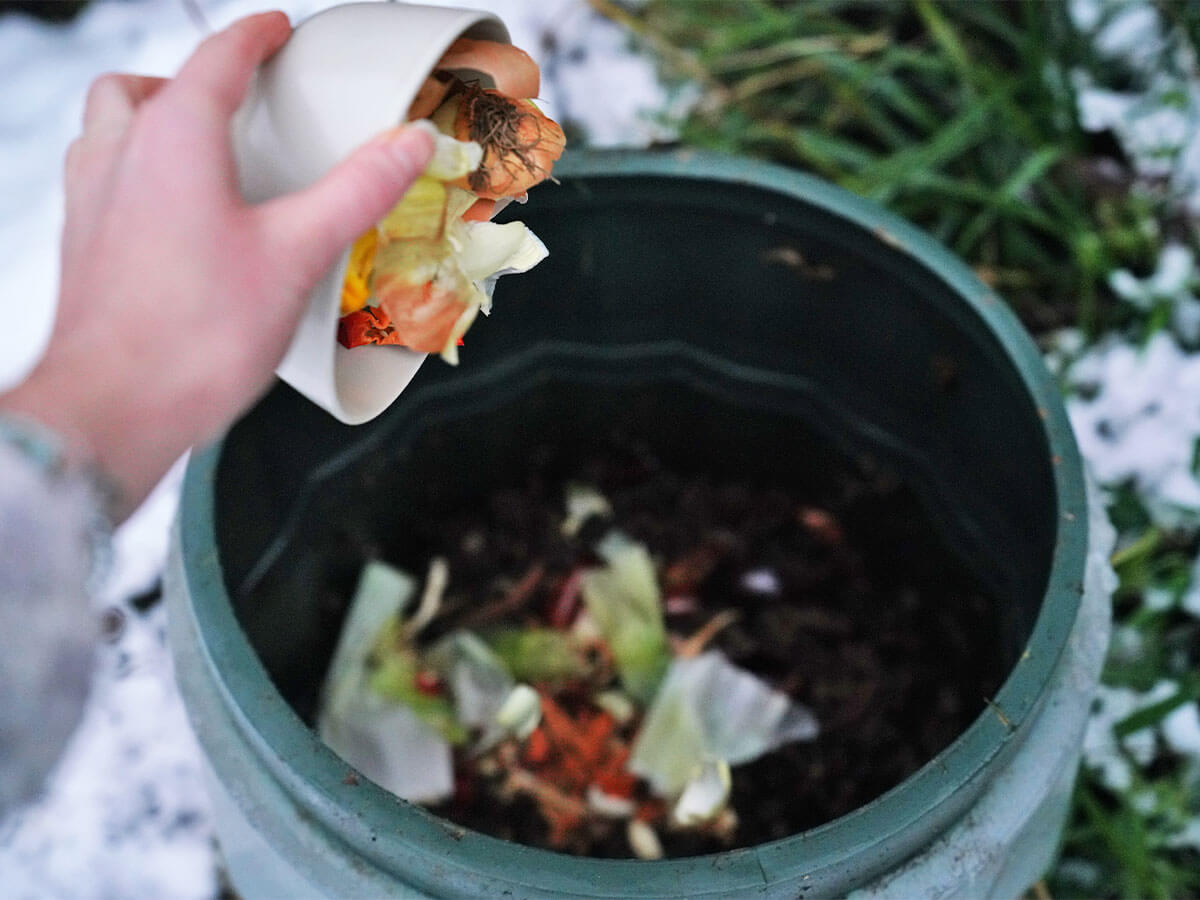Composting is a fantastic way to recycle kitchen scraps and yard waste into nutrient-rich soil for your garden. But when winter rolls around the colder temperatures can slow down the composting process, and even make it stop altogether…
Related Read | How to Compost in a Small Garden Space
However, with a little extra care, you can continue composting effectively all winter long! As the days get shorter and temperatures drop, it’s important to give your compost a little extra TLC to keep it active and healthy.
How to Keep Your Compost Pile Thriving During the Winter
In this blog post, we’ll explore how to maintain a compost pile during the colder months so you’ll have a rich pile of ‘black gold’ to use when Spring rolls around.
Disclaimer: This post contains affiliate links. When you make a purchase through one of these links I may earn a commission. This comes at no extra cost to you.
Why Continue Composting in Winter?
Even though decomposition slows down in the cold, composting during winter has its benefits. By keeping your compost pile active, you can build up a supply of rich compost ready to use in the spring.
Plus, continuing to compost helps reduce waste by keeping kitchen scraps out of the landfill. The key is to adapt your composting practices to suit the winter conditions.
So let’s jump in!
1. Choose the Right Location
Location is always key. If your compost bin is out in the open, it’s more susceptible to freezing temperatures and cold winter winds. To help maintain a steady temperature, consider relocating your compost bin to a spot that’s sheltered from the wind and gets a bit of sunlight.
This could be close to your house or apartment near a south-facing wall or under the cover of a tree or shrub. If you’re using a compost tumbler, you could even try moving it to a garage or shed during the coldest months.
This tumbling composter from Amazon has two chambers that allows one side to finish composting while the other side is still free for you to add fresh waste.
2. Insulate Your Compost Pile
One of the biggest challenges of winter composting is keeping the pile warm enough for the hard working microbes to continue breaking down organic matter. Insulating your compost pile can help retain heat and keep it active.
You can do this by surrounding the pile with straw bales, leaves, or even snow! Covering the top with a tarp or old blanket also helps to keep the heat in and prevent excess moisture from entering from rain or melting snow.
A compost thermometer like this one from Amazon is a good way to check the temperature of your compost bin. The optimum temperature for a compost bin is between 135º-160º Fahrenheit (57º-71ºC).
3. Maintain a Good Balance of Greens and Browns
During winter, it’s especially important to maintain the right balance of greens (nitrogen-rich materials like kitchen scraps) and browns (carbon-rich materials like dry leaves and straw).
Related Read | What Can You Put in a Balcony Compost Bin?
Since green materials like vegetable peels and coffee grounds are more readily available in winter, make sure to add enough browns to balance them out. This will help the pile decompose more effectively and prevent it from getting too wet and cold.
Remember, in smaller compost bins, there are some items you shouldn’t add to a compost bin.

4. Chop or Shred Your Materials
In winter, breaking down materials into smaller pieces can help speed up the composting process as it gives the microbes more surface area to work on! If possible, try and chop or shred kitchen scraps, cardboard, and yard waste before adding them to the pile.
The smaller the pieces, the easier it is for microbes to do their work, even in cooler temperatures.
5. Turn the Pile Regularly
Turning your compost pile helps aerate it, which is crucial for keeping the composting process going in winter. Even if the top layer of your pile freezes, the interior may still be active, and turning helps distribute heat and moisture throughout the pile.
Aim to turn the pile every couple of weeks, or whenever you add new material. A compost turner like this one from Amazon can make the job a lot easier!
6. Watch the Moisture Levels
It’s easy for a compost pile to become too wet during the winter as it’s a time of year when we add more green than brown waste. Each time you add new waste, keep an eye on the moisture levels.
If you open it one day and the pile seems too wet, try and add more browns like dry leaves or store-bought straw from a pet store etc. On the other hand, it seems too dry, mix in a bit of water or fresh green material.

7. Use a Compost Activator
If you notice that your compost pile is slowing down too much, you can try using a compost activator. These are materials that can help to jump-start the composting process by adding extra nitrogen or beneficial microbes.
You could even try adding natural activators like coffee grounds, alfalfa meal, or even a bit of fresh manure. Sprinkle a layer into the bin to give it a boost.
This natural compost accelerator from Amazon contains bacteria that can tolerate a wide range of temperatures and help boost the breakdown process. It’s kind of like probiotics but for your compost bin!
8. Consider Indoor Composting
If outdoor composting isn’t working out during the harshest winter months, you might want to try indoor composting methods. A worm bin (vermicomposting) or a Bokashi bin are both great options for composting kitchen scraps indoors.
These systems are easy to manage and can produce compost or compost tea right in your home, ready to use when spring arrives. This Bokashi bin kit from Amazon has all you need to get started with Bokashi composting!
Related Read | How to Vermicompost on a Balcony | 8 Steps
9. Collect and Store Scraps
If your outdoor compost pile is frozen solid, you can still collect kitchen scraps and store them until the weather warms up. Keep a sealed container or compost pail in your kitchen, and when it’s full, store it in a cold spot like a garage or basement.
Once your compost pile thaws in the spring, you can add these saved scraps all at once.

10. Patience is Key
Finally, remember that composting in winter requires a bit more patience. The process will slow down, and that’s okay. As long as you maintain your compost pile and keep adding materials, it will continue to break down. Come spring, you’ll have a head start on creating rich, organic compost for your garden.
Will you start a compost pile this winter?
Composting in winter may require a few adjustments, but it’s absolutely possible to keep your compost pile active and healthy throughout the cold months.
By following these tips, you can continue to reduce waste, enrich your garden soil, and make the most of your kitchen scraps all winter long.
You may also be interested in…
So the compost bin is working away… wondering what else you can do with your small outdoor space this winter? I’ve pulled together some of our other posts to inspire you!
Composting and containers…
- How to Reuse and Refresh Old Compost from Containers
- The Difference Between Hot and Cold Composting
- How to Compost on a Balcony
Winter planting ideas…





